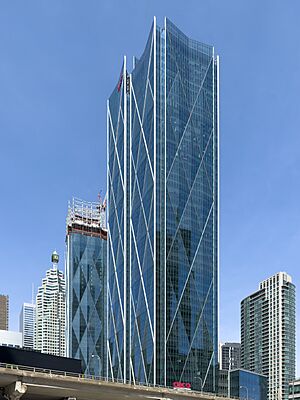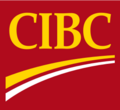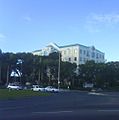Canadian Imperial Bank of Commerce facts for kids
 |
|

Headquarters at CIBC Square
|
|
| Public | |
| Traded as | |
| Industry | Financial services |
| Predecessors |
|
| Founded | June 1, 1961 |
| Headquarters | , |
|
Key people
|
|
| Products |
|
| Brands | CIBC Bank USA Simplii Financial |
| Revenue | |
| AUM | |
| Total assets | |
| Total equity | |
|
Number of employees
|
48,525 (FTE, 2024) |
| Subsidiaries |
|
The Canadian Imperial Bank of Commerce (CIBC) is a large Canadian bank that offers many financial services around the world. Its main office is in Toronto, Ontario, Canada. CIBC was created in 1961 when two older banks, the Canadian Bank of Commerce and the Imperial Bank of Canada, joined together. This was the biggest merger of banks in Canadian history.
CIBC is one of Canada's "Big Five" banks. It helps over eleven million customers globally. The bank has different parts that focus on banking for people, businesses, and wealth management. CIBC also has offices in the United States, the Caribbean, Asia, and the United Kingdom.
Contents
How CIBC Started
Before CIBC became one big bank, it was two separate banks with their own long histories.
Imperial Bank of Canada
The Imperial Bank of Canada was started in Toronto in 1873 by Henry Stark Howland. It grew by buying other smaller banks, like the Niagara District Bank in 1875. By the end of World War II, it was Canada's fifth-largest bank.
Canadian Bank of Commerce
The Canadian Bank of Commerce opened in Toronto on May 15, 1867. It was founded by William McMaster. This bank quickly grew and had 24 branches by 1874. When gold was found in the Yukon in 1896, the Canadian Bank of Commerce opened a branch in Dawson City to help miners.
By the 1920s, the Canadian Bank of Commerce had over 700 branches across Canada. It also opened international branches in places like Cuba and Jamaica. In 1931, its new head office in Toronto was the tallest building in the Commonwealth of Nations for many years. In 1936, it was the first Canadian bank to offer personal loans.
The Bank's Journey
Two Banks Become One
The idea for the two banks to merge started in 1960. The Imperial Bank of Canada's chairman, L. Stuart Mackersy, worried that a British bank might try to take over his bank. He decided it would be better to merge with another Canadian bank. He met with Neil J. McKinnon, the head of the Canadian Bank of Commerce. They quickly agreed to combine their banks.
On June 1, 1961, the Canadian Bank of Commerce and the Imperial Bank of Canada officially merged. They formed the Canadian Imperial Bank of Commerce. The new bank had over 1,200 branches and was the largest bank in Canada at the time.
New Ways to Bank
CIBC was always looking for new ways to help customers.
- In 1964, it even had a floating bank branch on a ship in Quebec!
- In 1967, CIBC was the only bank with a branch at Expo 67, a big world's fair in Montreal.
- Around this time, computers started changing banking. CIBC was one of the first to use computers to update customer accounts.
- Soon after, CIBC introduced the first 24-hour cash machine, which we now call an ATM.
In 1973, CIBC opened its new main office, Commerce Court West, in Toronto. This 57-story building was the tallest in Canada when it was finished.
Expanding Services
In 1987, new rules allowed banks to offer more services, like investment advice. CIBC was quick to start its own investment company, CIBC Securities. In 1988, CIBC bought Wood Gundy, a well-known investment firm. They combined them to create CIBC Wood Gundy, which later became CIBC World Markets.
CIBC also embraced technology for customers:
- In 1992, it launched automated telephone banking.
- In 1995, the bank launched its website and soon offered online banking.
- In 1998, CIBC teamed up with Loblaws to create President's Choice Financial, offering banking services in grocery stores.
In 1998, CIBC tried to merge with the Toronto-Dominion Bank. However, the Canadian government decided that this merger, and another one proposed by other banks, was not good for Canadians, so it did not happen.
The 2000s and Beyond
In the early 2000s, CIBC focused more on its main banking business. It sold off parts of its company that were not directly related to banking. For example, it sold its share in the Toronto Blue Jays baseball team in 2000.
CIBC continued to innovate with technology:
- In 2010, CIBC was the first Canadian bank to launch a mobile banking app for iPhone.
- It also became the first bank in Canada to offer a Visa-branded debit card.
In 2016, CIBC bought a bank in Chicago called PrivateBancorp. This bank was later renamed CIBC Bank USA in 2017, helping CIBC grow its business in the United States. Also in 2017, CIBC launched Simplii Financial, a new online-only bank, after ending its partnership with President's Choice Financial.
In 2021, CIBC moved its main office to a new building called CIBC Square in Toronto. This modern building is now the bank's main headquarters. CIBC is also exploring new technologies like artificial intelligence to improve its services.
How CIBC Grew Through Acquisitions
Over the years, CIBC and its original banks grew by joining with or buying other companies.
- The Imperial Bank of Canada acquired the Niagara District Bank (1875), Weyburn Security Bank (1931), and Barclays Bank (Canada) (1956).
- The Canadian Bank of Commerce acquired many banks, including the Bank of British Columbia (1901) and the Standard Bank of Canada (1928).
- After the merger, CIBC acquired Wood Gundy (1988), helped create President's Choice Financial (1998), and gained control of FirstCaribbean International Bank (2006). More recently, it acquired Atlantic Trust (2013) and Privatebancorp (2016), which became CIBC Bank USA.
Where CIBC Operates
North America
CIBC has a strong presence across North America.
- CIBC Bank USA is based in Chicago and serves customers in many U.S. states. It focuses on banking for businesses and individuals.
- Simplii Financial is CIBC's online-only bank in Canada, offering easy digital banking services.
Caribbean
CIBC has a long history in the Caribbean. The Canadian Bank of Commerce opened its first branches there in 1920, in places like Barbados and Jamaica. Over the years, CIBC expanded its network in the region. In 2001, CIBC combined its Caribbean operations with Barclays Bank to form FirstCaribbean International Bank. CIBC later took full control of this bank, rebranding it as CIBC FirstCaribbean International Bank in 2011.
Leadership at CIBC
CIBC is led by a team of experienced people. The main leaders are the President and Chief Executive Officer (CEO) and the Chair of the Board.
- The current President and CEO is Victor Dodig. He has been in this role since 2014.
- The Chair of the Board is Katharine B. Stevenson, who took on this role in 2021.
These leaders, along with other senior executives and the board of directors, guide the bank's decisions and future plans.
CIBC's Sponsorships
CIBC supports many different events and organizations.
- CIBC was a founding partner and the "official bank" of the Toronto Blue Jays baseball team until 2000.
- It was a lead partner for the 2015 Pan American Games and 2015 Parapan American Games held in Toronto.
- CIBC has partnered with companies like Petro-Canada for credit card rewards programs.
- It also supports educational institutions like the University of Waterloo Stratford Campus and Thompson Rivers University, helping students with financial awards and job opportunities.
- CIBC USA sponsors the Chicago Fire FC soccer team.
- CIBC is also a sponsor of the Northern Super League, Canada's top women's soccer league.
Images for kids
-
120 South LaSalle in Chicago, headquarters for CIBC Bank USA.
-
CIBC FirstCaribbean International Bank branch in Bridgetown, Barbados.
-
A billboard with CIBC's logo at a gymnastics event during the 2015 Pan American Games.
-
Construction for CIBC's new headquarters, CIBC Square in Toronto, in September 2018.








